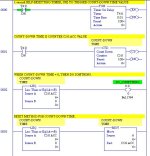Is it the case that the elapsed time registers in S7 count down whilst in RS500 (.ACC) they count up?
I've the following block of 7 code, where T33 is a 6 second timer
L "T33"
L 535
>=I
= "M21.0"
This suggests to me that M21.0 is true for the first 0.65 seconds of the timers operation, and the equivalent RS500 block would be
LES T4:82.ACC 65
I've the following block of 7 code, where T33 is a 6 second timer
L "T33"
L 535
>=I
= "M21.0"
This suggests to me that M21.0 is true for the first 0.65 seconds of the timers operation, and the equivalent RS500 block would be
LES T4:82.ACC 65









